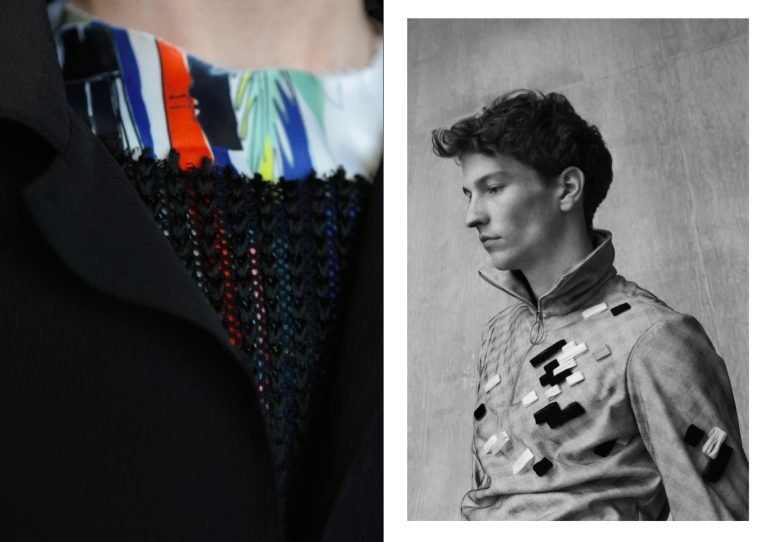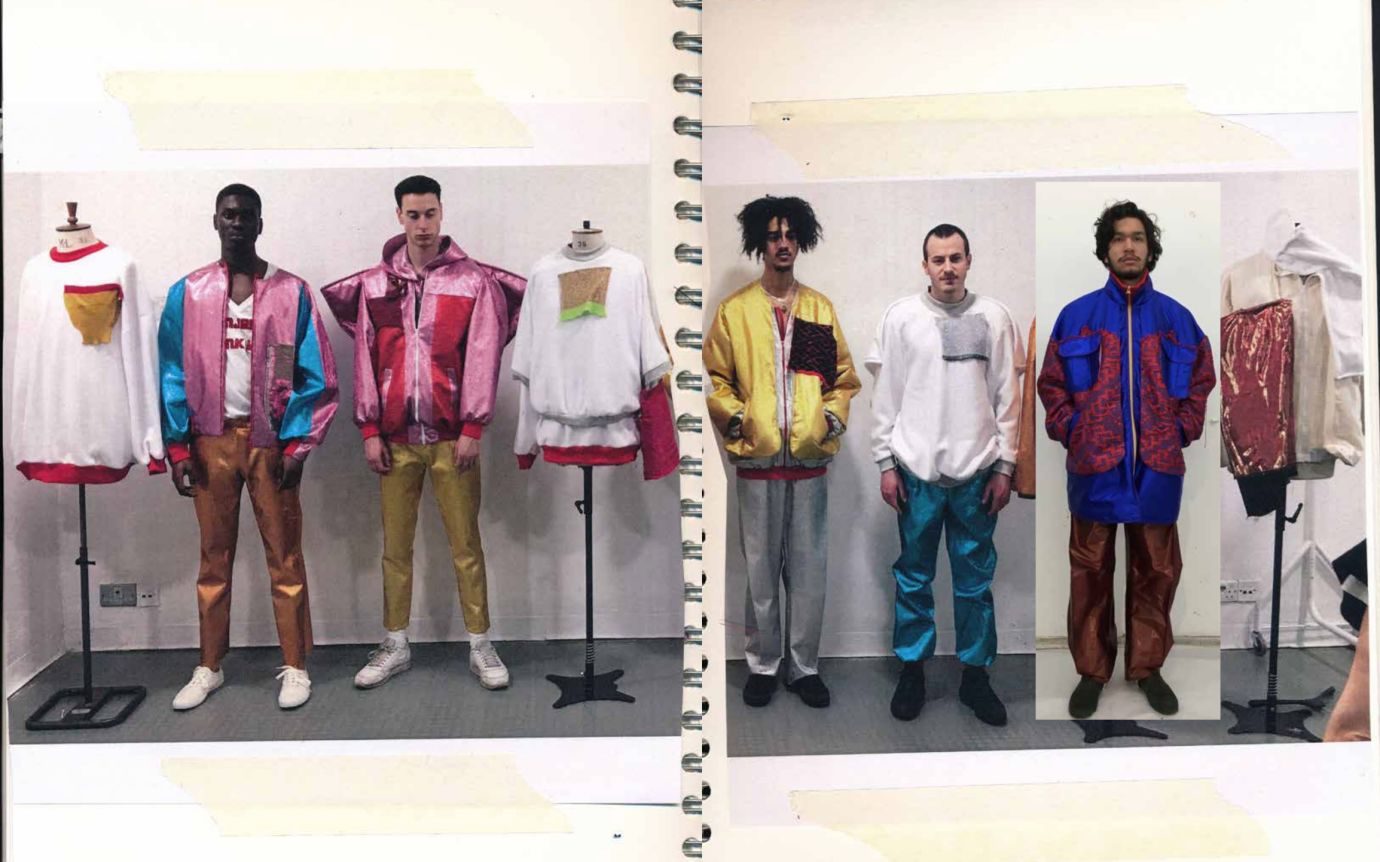Polly Henderson, West Sussex-born designer and graduate of the BA Menswear at Westminster University, says that she never had an ‘Aha! moment’ when it comes to choosing fashion as a career. “I’ve always loved the arts – I studied textiles and fine art at school, and competed as a semi-professional dancer until I was 18. But at the same time, I come from a family that’s very business-minded, so for me, choosing fashion was a logical thing to do and a good way of mixing being creative and coming up with practical solutions that will affect people.”
Polly Henderson: Between authentic and synthetic
The British designer is inspired in her process by the art of manipulating reality in photography
The designer recalls that the first piece of clothing she made on her own was a women’s shawl collar coat from a Vogue pattern dating back to the 1950s. “I think having done that, I realised that I really loved considering all the details of the coat – the colour, the cuffs, the buttons, the placket – just as much as thinking about the shape and the silhouette of the garment. And I think that this obsession with details is what drew me to wanting to do menswear,” says Henderson.
“I really love reading photographs and going very deep into one image; not just looking at the colours, the shape, or the characters within it, but also thinking about the point of view of the photographer, how staged the photo is or why it’s staged.”
For Henderson, the process of working on her graduate collection, Legendary Days, started out with an interest in photography and reading about the theory behind this art form: “I really love reading photographs and going very deep into one image; not just looking at the colours, the shape, or the characters within it, but also thinking about the point of view of the photographer, how staged the photo is or why it’s staged.”
The concept for the collection is based around New York (1993), an image by Philip-Lorca diCorcia, an American photographer who became famous for his semi-staged baroque compositions. “I like that even though it looks like a sweeping street scene, there are elements of it that are so theatrical and perfect that they have obviously been composed for the purpose of the image. And to me, that’s kind of what catwalk shows are: it’s about trying to make it seem like the boys put the clothes on their back themselves, but at the same time, we know that they are models and were told specifically how to wear the garments. So I really wanted to play with that idea of mixing authenticity with something that feels synthetic.”
This approach also continued in the physical process of creating the garments. Polly Henderson would source vintage classic menswear pieces and rework them with her customer in mind. “I would think: what’s a really authentic piece of clothing that this boy would wear? And then mix it with little weird twists that might accidentally turn up on him, like something that he randomly found or was given to him by a friend.” Consequently, the collection was created out of traditional heritage textiles, such as wools, tartans or wax cotton, which were then juxtaposed with elements created out of technical fabrics.
Henderson says that in her vision, she wanted to stand against the total look that has been perpetuated in the past few years by big fashion giants, such as Dior, Fendi or Louis Vuitton. “I think this approach doesn’t invite the customers to put their own sense of style into their clothes anymore. So with my garments, a real hope at the back of my mind is that people would be able to buy anything from my collection and it would slide into their personal style, so that they can make it their own,” she says.
For Henderson, the lockdown period became a good opportunity to explore the digitization of the design process, “Trying to transpose all of my process, which is quite tactile, onto the computer screen for the hand-in has been a real learning experience, but I think it’s a very important skill. I’m just about to start a new job as a shirt designer at Tommy Hilfiger, and one of the things that I’m really excited about is learning how to use all of the 3D rendering software. I know that many designers hate it because it can take away a bit of the design process, but for me, this way of working will be so powerful in the future. There’s such a scarce amount of materials left [on the planet], so if we use rendering, we don’t need to make a whole new sample of something, if it’s just a small change or a design development in the garment.”
While looking back at her time at Westminster, Polly Henderson admits that she has a fraught relationship with fashion education. “There wasn’t a very rigorous set of rules and regulations of how much we should learn and we didn’t learn enough practical skills. I don’t think that any fashion school in the world sets you up to go into the fashion industry. You have to be a very conscientious person and expose yourself to the knowledge that you will need to succeed.”
“The fashion degrees feel like they are 20 years out of date. They teach you how to be a creative director and have this big ego. And I don’t think that there’s any place for that in a future of fashion, or any industry, in a world that is teetering on the edge of extinction.”
She says that her advice for people who are thinking of doing a fashion degree would be to consider studying a more specific and practical course instead. “I think that so many great designers come out of courses such as product design or industrial design and having that practical skill can make you a more interesting creator. The fashion degrees feel like they are 20 years out of date. They teach you how to be a creative director and have this big ego. And I don’t think that there’s any place for that in a future of fashion, or any industry, in a world that is teetering on the edge of extinction.”
“It would be great to see a new structure in fashion. I think that we need to move the power away from the creative director. At the moment, we have these big figureheads and we wonder why things don’t change, but one person can’t be interested or know about all of the aspects of developing the business into a mindset that’s more fit for the future. It has to be a team effort.”
Henderson says that in the future, she would like to see the industry move away from the hierarchy that is currently permeating it, “It would be great to see a new structure in fashion. I think that we need to move the power away from the creative director. At the moment, we have these big figureheads and we wonder why things don’t change, but one person can’t be interested or know about all of the aspects of developing the business into a mindset that’s more fit for the future. It has to be a team effort.”














































